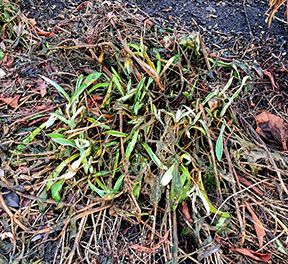 |
Previous Issues |
| Cedar Mill Community Website |
|
Search the Cedar Mill News: |
About The Cedar Mill News |
|
|||||||
| Volume 15, Issue 2 | Februrary 2017 |
||||||
Gardens looking haggard after snowfall? First, don’t panic!
|
||||||
 |
So, what should we do now?
Cut back any branches that broke to prevent further damage and reduce the risk of disease or insect infestation. If unbroken branches look dead, wait until they start to push new growth in late spring before you prune; they could just be faking it!
Bent, but not broken shrubs may treat their owners to a happy surprise by popping back up like Margie Lachman’s camellias and bamboo did. Lachman, gardening columnist for the Cedar Mill News, suggested using wide cloth strips or plant ties to gradually coax evergreens such as arborvitae, yews, and junipers, back to their upright stance. “Pull them up only two or three inches at a time,” she said. “It should be done gradually.”
 |
| Cornell Farm says these melted-looking perennials will likely bounce back in the spring, because their roots are healthy |
Evergreen trees and shrubs that bore the weight of the snow and the week's sub-freezing temps had a particularly tough time. But even if the leaves look burned, battered, or hopeless, leave them in place for now. They’ll be an eyesore, but will continue to function for the plant until it replaces them in the spring.
If we get more snow (it’s still winter, after all)? Get out there and gently brush or shake snow from shrubs, but ice should be left to melt when the weather warms said Lachman. “I have to admit that a few years ago, I saw my camellias covered with ice and panicked. Not wanting to lose my flowers I went down the row and shook each limb until the ice fell to the ground. Luckily nothing happened to my flowers or leaves despite advice to the contrary.”
Below ground, both garden experts recommend leaving well-enough alone. Perennials that look mushy likely have healthy roots. Allow them to rest undisturbed till spring when it will become apparent what’s still alive—or not.
And take heart; though the snowfall was much more than normal and seemed to last forever, it really came at the best possible time for our landscapes. “This deep into winter, we had already experienced enough cold to send most plants into dormancy, which makes them much less vulnerable to weather extremes," said Blatter.
![]()
Like us on Facebook for timely updates
Published monthly by Pioneer Marketing & Design
Publisher/Editor:Virginia Bruce
info@cedarmillnews.com
PO Box 91061
Portland, Oregon 97291
© 2017